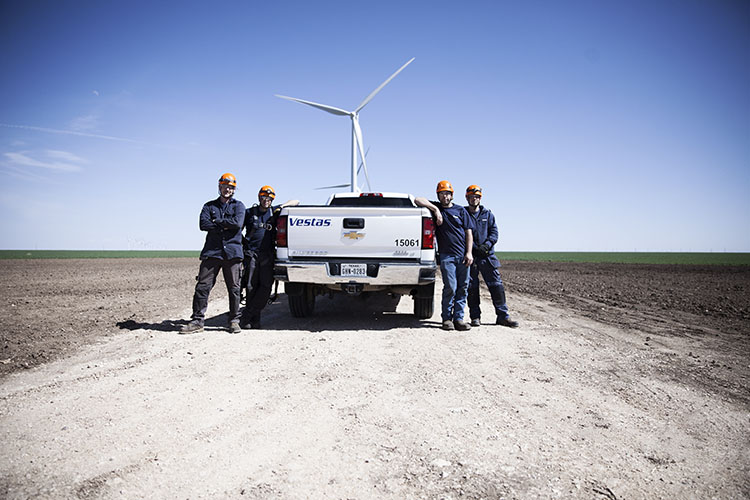As the wind sector evolves, services companies need to develop new offerings to meet changing demands. By capitalizing on new data and information, companies can create lasting partnerships with customers.
In this post we talk with Peter Wells, vice president of Vestas’ service operations, about the state of the industry, where it’s heading and how communications with customers are evolving.
What are some of the biggest changes to the wind energy services space in the past few years?
Fundamental challenges remain the same, such as recruiting and retaining good technicians, implementing adequate training programs, planning logistics for remote locations, developing safety and quality programs, and finding systems and tools to support the field.
As platforms, customers and service organizations evolve, we’re seeing more diversity in our clients’ needs, wants and approaches to doing business. Things like higher hub heights, mixes of technologies across one park, aging assets and the need to support multiple OEM technologies are all part of the equation. We increasingly work to provide customers with tailored service packages that range from operational support to full-service scope, including major components and production risk. These are all examples of new dimensions that require greater capability sets within our service group.
On top of that, we are now seeing our service capacity increase significantly and at pace, with the number of turbines in our service fleet doubling every three to four years. The challenge here is that growth cannot undermine core operational progress, where we need to continually maintain and improve systems, process, tools, training, safety and quality.
How has Vestas evolved service offerings to meet some of these changes?
Vestas is focusing on the fundamentals of operational excellence, such as expanding the scope and content of our safety and quality programs, developing additional training options and requirements, and expanding our thinking on systems and tools for site management and fleet performance.
From this foundation, we build out. We are developing offerings that support customers who want to perform basic maintenance service themselves or customers who want to transfer more risk to us — including production. We’re also working on products and services that refurbish and repower assets to improve performance and extend asset life. Other areas of focus for us include offerings that recognize the importance of data collection and analytics, as well as options for how customers and service providers can work together on e-commerce approaches.
How has the way you communicate with customers changed as well?
Frankly, it hasn’t changed enough. We are certainly more open and transparent, but we need to move beyond our current OEM communication paradigm and look for ways to drive greater collaboration via better communication. We should take note of how other industries open up IPs to drive greater innovation and progress. Ultimately, I believe this will benefit customers and OEMs with more diversity of thought and more solutions. It will also foster greater networking that will deliver mutual returns that are fair, appropriate and add value for customers.
What types of tools are you developing to help drive data insights?
In 2017, we are launching a holistic data platform called VestasOnline. In this online environment, customers can retrieve needed information, ask questions, procure parts and access an analytical platform called ClearSight.
ClearSight is a comprehensive tool kit of modules that spans the wind energy value chain from development to production to energy trading. These tools drive insights for customers and Vestas, enabling better products and services, better operational decisions and smarter business.
What changes do you expect to see in the coming years, and how will Vestas need to respond to those?
We expect to see bigger turbines and increasingly modular approaches to turbine configuration that enable wind farms to maximize the production potential of wind parks and assets. Turbines will also be networked for smarter operations, and we’ll see advances in turbine diagnostics that may be automated at the turbine level. Longer commercial commitments to products will extend warranties and service agreements, and we’ll see greater flexibility in service contract structures defined by customers and market innovators.
At the high level, the response is simple: We need to define our future by lowering the levelized cost of electricity (LCOE) with more efficient and cost-effective product and service designs. At a more detailed level, it means a lot of work such as scaling up, improving diagnostics and dealing with a mix of turbines that feature old, new and different technologies. We will also be creating detailed and comprehensive training, quality and safety programs that innovate, define excellence and improve performance. Our workforce will evolve as we enable personal growth and career longevity for our field operatives.
Service organizations need to move from being the aftermarket in terms of what follows the turbine sale to the market leader, where operations and what we want from our wind farm operations define the product, and older assets become part of the opportunity pipeline for new turbine sales.
For more information, visit www.vestas.com
Peter Wells is vice president of service operations for Vestas in the United States and Canada, where he leads a team of more than 1,500 employees with more than 22 GW of projects under long-term contract. Prior to joining Vestas, he served as CEO of UpWind Solutions Inc., the leading independent service provider in North America. During his four-year tenure, he led the company’s fourfold growth to become the most successful ISP in the US market and guided its acquisition by Vestas.
